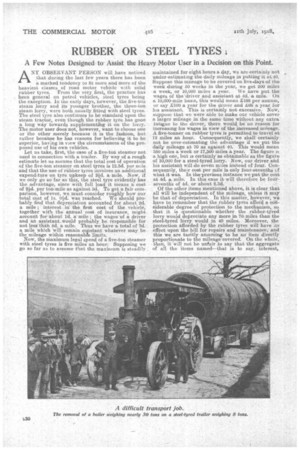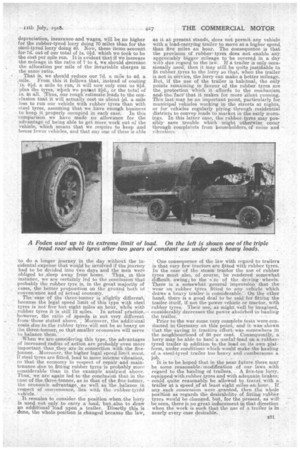RUBBER OR STEEL TYRES 1
Page 8

Page 9

If you've noticed an error in this article please click here to report it so we can fix it.
A Few Notes Designed to Assist the Heavy Motor User in a Decision on this Point.
ANY OBSERVANT PERSON will have noticed that during the last few years there has been a marked tendency to fit more and more of the heaviest classes of road motet' vehiclewith solid rubber tyres. From the very first, the practice has been general on petrol vehicles, steel tyres being the exception. In the early days, hoWever, the five-ton steam lorry and its younger brother, the three-ton steam lorry, were both .usually fitted with steel tyres. The steel tyre also continues to be standard upon the steam tractor, even though the rubber tyre has gone a long wiy towards supplementffig it on the lorry. The motor user does not, however, want to choose one or the other merely because it is the fashion, but rather because he has reasons for believing it to be superior, having in view the circumstances of the pro
posed use of his own vehicles. .
Let us take, first, the case of a five-ton steamer not used in connection with a trailer. By way of a rough estimate let us assume that the total cost of operation of the five-ton steamer on steel tyres is 12.5d. per mile and that the use of 'libber tyres involves an additional expenditure on tyre upkeep of 20. a mile. Now, if we only go so far as this, the steel tyre evidently has the advantage, since with full load it means a cost of 2id. ,per ton-mile as against 3d. To get a fair comparisbn, however, we must consider roughly how our total cost of 1.S. 04:1. was reached. . We should piobably .find that depreciation accounted for about 2d. i a mile ; interest n the first cost of the vehicle, together• withr theannual cost of insurance, might account for about Id. a mile ; the wagescof a driver and an assistant-would probably be responsible for not lest than zid. a mile. Thus we have a total of 7d. a mile which Will remain eopstant whatever may be the mileage within reasonable limits.
Now, the Maximum legal speed of a five-ton steamer with steel tyres is five miles an hour. Supposing we go so far as to assume that the maximum is steadily _ maintained for eight hours a day, we are certainly not under-estimating the daily mileage in putting it at,40. 'Suppose this mileage to be covered on fivesda,ys of the week during 50 weeks in the year, we get 200 miles
-a week, or 10,000 miles a year. We have put_ the wages of the 'driver and assistant a,t. 4d. a mile. On a 10,000-mile basis, this would mean 2166 per annum, or say £100 a year for the driver and £66 a year for his assistant. This is certainly not excessive. No*, suppose that we were able to make our vehicle cover a larger mileage in the same time without any extra" fatigue to the driver, there would be no reason for increasing his Wages in view of the increased mileage. A five-tanner on rubber tyres is permitted to travel at 12 miles an hour. Consequently, we shall certainly not be over-estimating the advantage if we put the daily mileage at 70 as against 40. This would mean 350 miles a week or 17,500 miles a year. The figure is a high one, but is certainly as obtainable as the'figui7e of 10,000 for a steel-tyred lorry. Now, our driver and his assistant will do seven miles instead of four. Consequently, their cost per mile is only four-sevenths cf what it was. In the-previous instance we put the cost at 4d. a .mile:. In this ease it will therefore be loutsevenths of 4d. or about 2.3d.
. Of the Other items Mentioned above, it is clear that all *ill be independent Of the mileage., unless it may be that of depreciation.. In this matter, however, we have to remember that the rubber tyresafford a 'vansiderable degree of protection to the Mechanism, so that it is questionable whether the . rubber-tyred lorry would depreciate any more in 70 miles thanthe steel-tyred. Jerry would in 40 miles. Moreover, the protection afforded by the rubber tyres will have its effect upon the bill for repairs and maintenance, and this we are tacitly assuming to be an item directly proportionate to the mileage-covered. On the whole, then; it will not beunfair to say that the aggregate of all the items named—that is to say, interest,
depreciation, insurance and wages, will be no higher for the rubber-tyred lorry doing 70 miles than for the steel-tyred lorry doing 40. Now, these items account for 7d, out of our total of Is. 00. which we took to.be the cost per mile run. It is evident that if We increase the mileage in the ratio of 7 to 4; we should decrease the allocation per mile of the invariable 'charges iii the same ratio.
That is, we should reduce our 7d. a mile to 4d. a ;mile. From this it follows that, instead of costing Old. a mile to run, it will now only cost us plus the tyres; wtich we put•at 2,N., or the total of ls, in all. :Thus, our rough'estimate leads to the conclusion that it will actually cost us about d. a mile less to run our vehicle with rubber tyres than with steel tyres,. assuming that we have enough business to keep it properly occupied in each case. In this comparison we have made no allowance for the advantage of being be to get more work out of the vehicle, which means that we require to keep• and house fewer vehicles., and that any one or them is able to do a longer journey' in the day without the incidental expense that would be involved if the journey had to be divided irito two days and the men were obliged to .sleep away from home. Thus, in this instance, we are certainly led to the conclusion that i
probably the rubber tyre s; in the great majority of cases, the better proposition oh the ground both 'of -convenience. and of actual econoiny. The case of the thice-tonner'-is sligbtiy different,because the legal speed limit of thistype with steel tyres is not fivebut eight miles .an hour, While With rubber tyres it is still' 12 miles. In aetual.-practiee,--; however; _the' ratio of Speedsis not. very. different from-those' stated above. Moreover, the additional costs d_iie: to the rubber -tyres will:not-be so heavy on the three-tormer; so that smaller economies will serve to. balance them." :-. :When we are considering this type, -the advantages of inofeaSed. radius of .action are probably even more importantthan they are -in connection with the ifive_tanner. Moreover, the higher legal speed limit Must, ii steel tyres are fitted, lead to more intense vibration, so that -the economy in respect. of -repair and -maintenance due to fitting rubber tyres is probably more considerable than in the example analysedabove. Thu,' we are again, ledto-theconclusion that in the tase of-thethree-tormer, as in that of the•fiie-ionrier, the economic, advantage, as well-. as the balance. in respect .of ,conyenience,..licswith. the -ilibber,tyi-e-d It remains to -consider the position .when.the lorry is used not only to carry aload,but -also. to draw an additional' lead upon a trailer. Directly this is done, the whole position is changed because the law, as it at present stands, does not permit any vehicle with a load-carrying trailer to move at a higher speed than five miles an hour. The consequence is that the provision of rubber.: tyres does not enable any apPreciably bigger Mileage to be covered in a day with due regard to the. law: If a trailer is only occasionally used, then it May still be quite justifiable to fit rubber tyres to the lorry so that, when the trailer is not in service, the lorry can make a better mileage. But, if the use of the trailer is habitual, the only points remaining in favour of the rubber. tyres are the „protection which it affords to the mechanism andthe-fact' that it makes for more silent running. This•last may be an important point, particularly for municipal vehicles working in the streets at nights, or for vehicles regularly plying through residential districts to convey loads to market in the early mornings. In this latter case, :the rubber. tyres may possibly save trouble which might othe.14-ise occur through complaints from 4ouseholclers, of noise and vih vs. ti One consequence of the law with regard to.trailers is that very few tractors are fitted with rubber tyres. In the case of the steam tractor the use of rubber tyres must also, of course, be rendered Somewhat difficult. owingi to the s.ze • of the driving: wheels. There is it someivhatgenera' impressionthat the wear on rubberfitted to any vehicle which drawsa' heavy tailer considerable:. On the other hand, theife•is a good deal to' be said for fitting the trailer. itself, if, not the power vehicle or tractor, with rubber tyres. Their use; a.s /night iniagined; consklerablY decreases the power, absorbed in-hauling the' trailer: Prior to the war some very complete tests-were conducted.in Germany on this point;: and-it was-shown . that the :saving in tractive effort:was •somewhere in the neighbourhoodof -50 -per cent. Consecipel:tily; . lorry may. be -able to haul la useful lead oh-a rubber.tyred trailer -in additionto-the load on its own plat7 : form, -under conditions which-would make .the hauling
• of.a steel-tyrecl drailer too heavy andcumbersome a jab. It is to be hoped that in the near future,there may be some reasonable modification of our laws with regard to the hauling of trailers. A five-ton-lorry, equipped.with,rubber-tyres and with adequate brakes;
could quite reasonably: be allowed to . travel:with 'a
trailer at a speed .of at leaSt rhilea:air.hour. _ If any n .sucb .coeession were granted, then the whole positiOn as-regards the desirabilityof fitting. rubber tyres would be changed, but, for the .present, as willbe_ seen, there is no great inducement in that direction when the Work is shah that the use of a trailer is in nearly every case desirable.






















